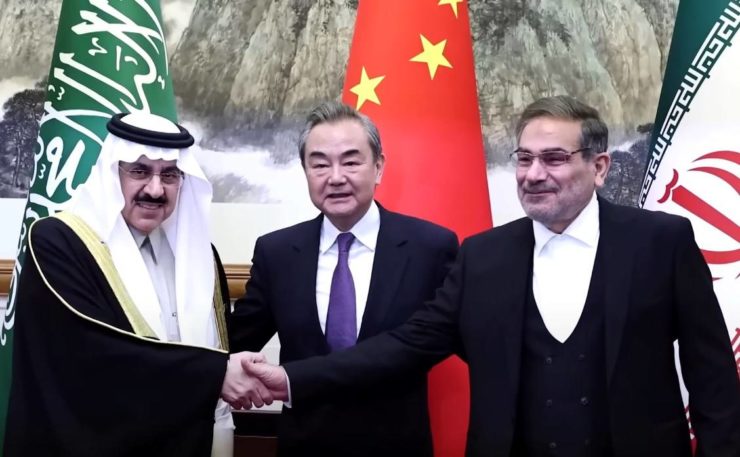
The United States policy shift from the Middle East to the Indo-Pacific has provided space for China to expand its influence in the region. China is now reshaping the regional dynamics in the Middle East by playing a larger-than-ever role. Recent developments in the Saudi-Iran deal and the inclusion of some Middle Eastern Countries in the BRICS indicate China’s interests in the Middle Eastern region encompass economic, geopolitical, and strategic issues along with traditional energy needs. China has established closer relations with multiple regional organizations for many years, but is now expanding its regional engagement by signing different agreements with several Middle Eastern countries. In the past, China signed the China-Arab States Cooperation Forum (CASCF) in 2004, and the China-Gulf Cooperation Council (GCC) Strategic Dialogue in 2010 along with some other agreements. Moreover, China published an Arab policy paper in 2016 which provides a deep insight into the country’s policies and its interests in the region.
China’s commitment to fostering strategic partnerships and promoting economic development beyond its traditional energy interest in the region is evident from China’s first China-Arab States Summit and its first China-GCC Summit in the year 2022. This rising involvement of China in the Middle East is molding the geopolitical dynamics in the region to a great extent and is also impacting the international world order. All this implies that China is all set to expand its economic and political interests globally to secure its reach to vital resources and Middle Eastern markets. In addition, China’s policy of non-interference in the domestic issues of its allies has made it an appealing option for the Middle Eastern countries to diversify their economic and strategic relations. This provides Middle Eastern countries an opportunity to exercise greater autonomy and flexibility in their domestic and international affairs.
China has accentuated its trade with Middle Eastern countries and has replaced the European Union as the GCC’s largest trading partner with bilateral trade in the year 2020. China has signed multiple trade agreements with the Gulf countries in recent years. Furthermore, Beijing’s developmental projects in the Middle East through the Belt and Road Initiative (BRI) have also become a vital tool for expanding its political clout in the region. China is also developing a maritime route under the BRI project to cater to its energy needs from the Middle East. Most of the Chinese BRI investment projects in 2021 include the countries in the MENA region. Almost 23 percent of Chinese BRI engagements have been received by Middle Eastern countries in 2022.
China has invested approximately $10.5 billion in construction contracts in Iraq’s top recipient in 2021. Furthermore, China has invested $10 billion in building infrastructure in the Autonomous Kurdistan Region in northern Iraq. Additionally, Iran has also received almost 10 percent of the total BRI budget along with the development of Chabahar Port, and Jask port to the south of the Strait of Hormuz. Moreover, the Middle Eastern countries are seeking digital advancement and China has secured 5G deals under its Digital Silk Road. Saudi Arabia is also supporting China’s investment in advanced technology and research. Israel and China have also boosted their cooperation in technology, infrastructure, and security, which has also irked the United States. All these economic and strategic interests of China in the Middle East and its fraternal relations with the regional countries have motivated it to strive for peace and stability in the region. China is also burgeoning its arms sales in the region and has conducted military exercises with two of the region’s key stakeholders, Iran and Saudi Arabia, along with Russia. It has also promoted the idea of joint production of weapons. China is rapidly filling the void created in the region by the United States’ shift of focus from the Middle East to Southeast Asia. After the United States refused to provide advanced weapons to the regional states, China has hastened to fill this gap by providing modern weapons to several regional countries.
China has also been a key mediator in high-profile regional conflicts including the Afghan issue, the JCPOA negotiations along with the peace effort in Syria and Yemen peace process. Moreover, the inclusion of Saudi Arabia and Iran into BRICS, while KSA, Iran, and Qatar are already members of the SCO, and the proposal of de-dollarization from the BRICS forum have raised suspicions among the Western countries. Iran’s inclusion in the BRICS and its improving relations with Saudi Arabia, Russia, and China could also make the US sanctions on the former redundant. Undoubtedly, China is a rising superpower of the world and also proved a more reliable ally than the United States. The rising influence of China in the Middle Eastern region would have multipronged impacts on the regional as well as global powers. China’s increasing involvement and cooperation in the Middle East improves its soft image and expands its political clout in the region. Middle Eastern countries would now see China as an alternative to the United States for their financial, developmental, and security needs. Burgeoning Chinese influence in the region threatens Israel and the United States’ hegemony in the region and at the global level. The United States needs to improve its soft image and reevaluate its policy towards the Middle East to establish itself as a reliable ally for the regional countries.
Abbas Hashemite- is a political observer and research analyst for regional and global geopolitical issues. He is currently working as an independent researcher and journalist, exclusively for “New Eastern Outlook“.
